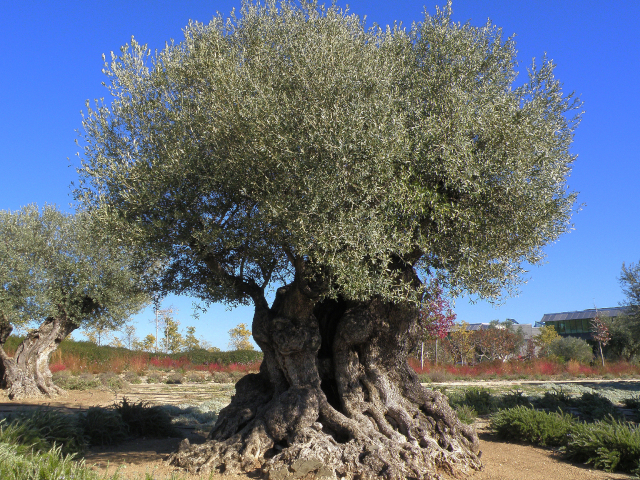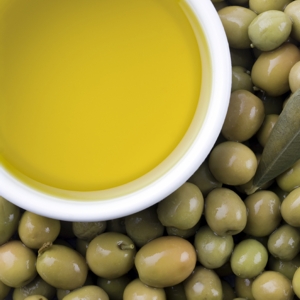According to official EU economic statistics, the global commodity price of Olive Oil was 50 percent higher last month than it was a year before. The price shock is the result of a massive crop failure. And some say an entire ‘culture’ is in crisis…
 An ancient and venerable Olive Tree: Could be more than 150 years old…
An ancient and venerable Olive Tree: Could be more than 150 years old…
Price rise unabated
The official EU economic statistics agency, Eurostat, reports that the world trading (bulk, wholesale) price of Olive Oil was up more than 50 percent last month, over the same month last year. And it was up more than 125 percent over the average price between 2000 and 2020.
If you regularly buy olive oil, you’ll have noticed retail price hikes. But my quick survey of the major Canadian sup0ermarket chains’ online stores indicates a slower, less-frantic increase than is reflected in ‘world’ prices. That’s probably because the big retailers have standing contracts with their importer-suppliers that guarantee them lower prices for a certain period of time. So, it’s the middlemen who are getting squeezed.
Nevertheless, some consumers are ringing alarm bells over retail price hikes. Funny… It’s like they hadn’t noticed until now.
But rise in prices being demanded from consumers is also buffered by the presence of a world ‘inventory’ of oil produced at lower prices, in years prior to the crop failure.
Nevertheless, the price will continue to increase. And olive oil may ultimately be priced out of reach for many ‘average consumers’ by the end of this year.
More than just a commodity
Boomberg food economy writer Javier Blas observes, in a Washington Post (WAPO) analysis, that last year’s crop failure – caused by record hot, dry weather, is more than just a matter of numbers and trend graphs.
“In southern Europe and the Levant, olive oil is as much culture as food, a way of life around shared customs on the shores of the Mediterranean Sea. For many families in the region, its price has come to symbolize the struggle against rampant inflation.”
Olive oil is not only an economic cornerstone of the Mediterranean world. It’s the foundation of an entire culture that traces its history – and cuisines – back to pre-Christian times. In fact, the Phoenicians are credited with spreading the olive tree across the Med as early as early as 1400 BC. Olives, as we know them, have been around ‘in the wild’ in the eastern and southern Med for at least 20,000 years.
Not a major player
Perhaps surprisingly, olive oil is not a major player on the greater, global edible oil market.
“Beloved as it is in southern Europe, olive oil accounts for a tiny fraction of global edible-oil consumption,” Blas reveals. “In 2020, it represented less than 2 percent of the global market, on par with cottonseed and coconut oil. Palm oil and soybean oil together account for 2 percent of the market; sunflower and rapeseed oil represent another 2 percent combined.”
But for those who cherish it – and cooks who simply can’t get along without it – the situation is at best troubling. At worst, it’s alarming.
Good news, bad news
The good news, looking forward a year or two, is that existing inventories of olive oil should carry the world through the aftermath of the crop failure. That’s assuming many folks – mainly outside the Med region – will stop buying olive oil as a result of rising prices, and moderate demand.
And that’s assuming there isn’t another crop failure hot on the heels of the last one. With the Climate Change situation as chaotic as it is, who knows?
As soon as the next regular olive oil crop is pressed and enters the commodity supply chain, things should go back, more or less, to normal. But we all know inflation will march on unabated. So the retail price of olive oil can be expected to continue a slow, steady increase.
My take
Knowing how much the Med cultures value olive oil, I believe they’ll find a way to make sure the olive tree survives Global Warming. God bless ’em. But that might well mean moving the olive plantations north. Into what’s now Europe’s wine country? Well, wine scene observers are already predicting that growers will have to move their vines north as the world warms. Making the UK and Scandanavia the focus of for the preservation of the ancient and noble grape varieties.
Olive growers, like wine growers, have started developing new varieties of their precious plants that can withstand hotter, drier weather. But it takes years for both of those plants to reach maturity, when they can begin to bear fruit.
For vinifera grapes, the first fruit may appear in as little as 5 years. But it may take as long as 12 to 15 years for that vine to produce in commercial quantities. Olive trees may take even longer. They can bear fruit in as little 5 years. But it can take anywhere from 20 to 30 years for the trees to reach a size at which they can produce in commercial quantities. Only when they reach a ripe old age of 150 years or so do olive trees begin to decline in productivity.
So wine and olive lovers may both, at some point, have to wait out a considerable succession of thin years for supplies and prices of their favourite fruits to stabilize.
~ Maggie J.

